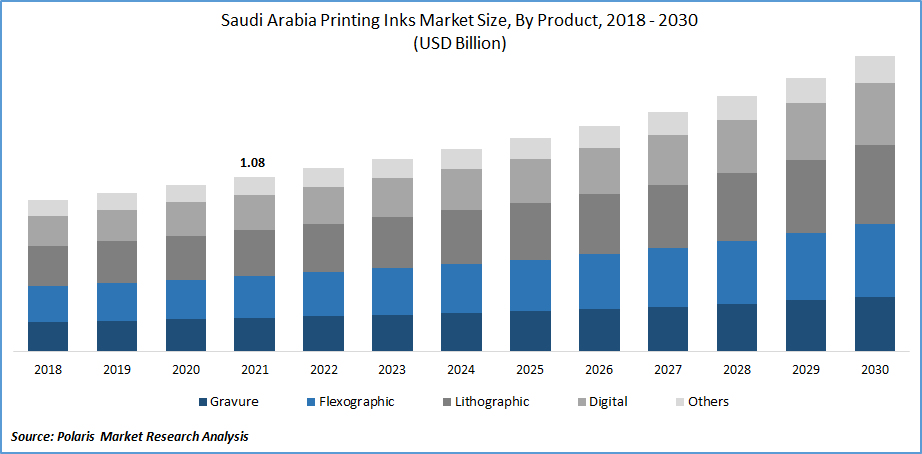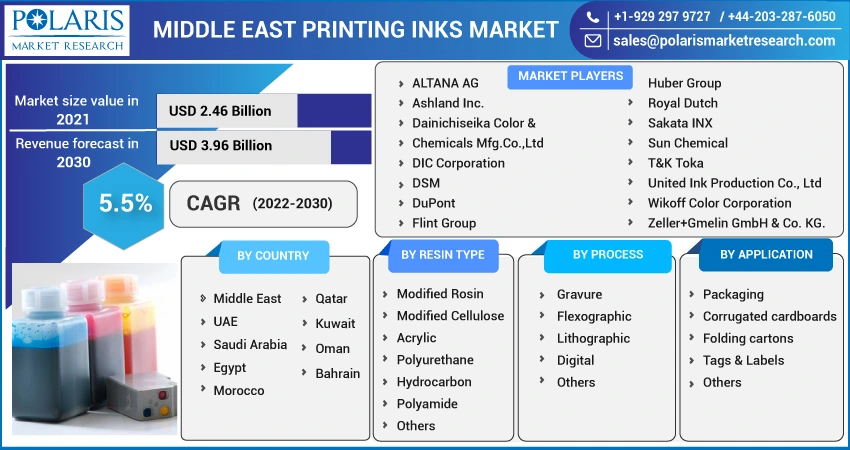
Middle East Printing Inks Market Share, Size, Trends, Industry Analysis Report By Process (Gravure, Flexographic, Lithographic, Digital), By Resin (Modified Rosin, Modified Cellulose, Acrylic, Polyurethane, Hydrocarbon, Polyamide), By Application, By Countries, Segment Forecast, 2022 - 2030
- Published Date:Jan-2022
- Pages: 119
- Format: PDF
- Report ID: PM1583
- Base Year: 2021
- Historical Data: 2018 - 2020
Report Outlook
The Middle East printing inks market was valued at USD 2.46 billion in 2021 and is expected to grow at a CAGR of 5.5% during the forecast period. The growing need for energy-curing inks for design and printing applications is expected to drive the market of Middle East printing inks over the forecast period.

Know more about this report: request for sample pages
The growing demand for packaged goods due to the COVID-19 pandemic has boosted the Middle East print inks industry and is expected to grow over the forecast period. Consumers prefer packaged commodities over loose products because of their inherent security. This opens up new potential for the whole FMCG value chain, including the print inks business in the Middle East.

Know more about this report: request for sample pages
Market Dynamics
Growth Drivers
Resin-based printing inks are widely used for packaging applications, such as flexible packaging, which will increase the demand for ink resins, fueling the Middle East market growth. Increasing consumer worries about harmful volatile organic compound (VOC) emissions and toxic metal substances across several solvents, along with a shift in consumer desire for increased energy inks as well as a growing need for these product lines from end-use segments are expected to drive the Middle East printing inks market.
Restraints
The popularity of e-books is spreading fast worldwide, which will certainly harm the worldwide publishing business, which is another big user of printer inks. The use of paper for printing has started to drop, which in turn is expected to continue over the forecast period. As a result, these aspects are expected to hinder product development in the Middle East over the forecast period.
Report Segmentation
The market is segmented on the basis of resin type, process, application, and region.
By Resin Type |
By Process |
By Application |
By Region |
|
|
|
|
Know more about this report: request for sample pages
Insight by Resin Type
Acrylic resin type segment is expected to dominate the market over the forecast period due to its properties such as flexibility and cost-effective design. Moreover, the faster recovery properties of acrylic are also expected to fuel the product demand in the Middle East over the forecast period.
Acrylic resin coverings are plastic or thermoplastic resin films, or acrylic radiative coatings, that are created by crosslinking acrylic resin with primary bodies including styrene, methyl acrylate, as well as other acrylic acids. As a result, acrylic has strong heat and water durability, better light and color stability, and is cheap to repaint and repair. Polyamide resins type is expected to grow at a considerable pace over the forecast period due to increasing demand for packaged materials owing to the growing tourism industry as polyamide resins are used for flexible packaging.
Insight by Process
Flexographic process segment is expected to grow at a significant pace over the forecast period owing to its wide applications. Flexo print inks allow prints upon a range of materials at a low cost. It is designed to print strong cardboard boxes, paper bundles, folded cartons, plastic bags, dairy and beverages boxes, disposable utensils and cartons, labels, bonding adhesives, postcards, newsprint, and local supermarket packaging.
Gravure prints process is expected to grow at a steady pace over the forecast period as these are used for high-end applications, including cartons, catalogs, newspapers supplements, along magazines. Increasing demand from these applications is expected to increase the demand for gravure prints over the forecast period.
Insight by Application
Packaging application segment is expected to hold the majority of the Middle East printing inks market shares over the forecast period due to increasing applications in digital prints along with the boom in online retail. Furthermore, the increasing demand for bio-degradable products and the growing middle-class income population are expected to fuel the segment demand.
Geographic Overview
Saudi Arabia dominated the Middle East printing inks market in 2021 and is expected to maintain its dominance over the forecast period. Increasing demand for packaging ink from the food & beverage industry, along with the presence of broad food & beverage companies in the country, is expected to fuel the country's growth over the forecast period.
Competitive Insights
Some of the major players operating in the Middle East printing inks market include ALTANA AG, Ashland Inc., Dainichiseika Color & Chemicals Mfg.Co.,Ltd, DIC Corporation, DSM, DuPont, Flint Group, Huber Group, Ink Products Company Limited, Royal Dutch Printing Ink Factories Van Son, Sakata INX, Siegwerk Druckfarben AG & Co. KGaA, Sun Chemical, T&K Toka, TOKYO PRINTING INK MFG Co Ltd, United Ink Production Co., Ltd, Wikoff Color Corporation, and Zeller+Gmelin GmbH & Co. KG.
These companies are investing in research & development to introduce advanced technology products and are adopting strategies such as mergers & acquisitions, along with partnerships & collaborations in order to increase their market presence and to expand their customer base. For instance, in May 2021, Paper Excellence, a worldwide producer of pulp and prints, writing, specialty, and packing papers, paid about (US)$3 billion for Domtar, North America's biggest integrated manufacturer of uncoated free-sheet paper.
Middle East Printing Inks Market Report Scope
|
Report Attributes |
Details |
|
Market size value in 2021 |
USD 2.46 billion |
|
Revenue forecast in 2029 |
USD 3.96 billion |
|
CAGR |
5.5% from 2022 - 2030 |
|
Base year |
2021 |
|
Historical data |
2018 - 2020 |
|
Forecast period |
2022 - 2030 |
|
Quantitative units |
Revenue in USD million/billion and CAGR from 2022 to 2030 |
|
Segments covered |
By Resin Type, By Process, By Application, By Region |
|
Country scope |
Saudi Arabia, UAE, Qatar, Kuwait, Oman, Bahrain, Morocco, Egypt |
|
Key Companies |
ALTANA AG, Ashland Inc., Dainichiseika Color & Chemicals Mfg.Co.,Ltd, DIC Corporation, DSM, DuPont, Flint Group, Huber Group, Ink Products Company Limited, Royal Dutch Printing Ink Factories Van Son, Sakata INX, Siegwerk Druckfarben AG & Co. KGaA, Sun Chemical, T&K Toka, TOKYO PRINTING INK MFG Co Ltd, United Ink Production Co., Ltd, Wikoff Color Corporation, and Zeller+Gmelin GmbH & Co. KG. |
